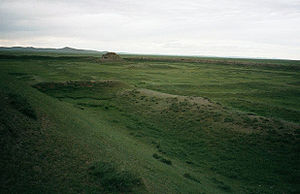- Ordu-Baliq
-
Ordu-Baliq[dn 1] (meaning "city of the court", "city of the army"), also known as Mubalik, was the capital of the first Uyghur Empire, built on the site of the former Göktürk imperial capital, 17 km north-to-northeast of the later Mongol capital, Karakorum. Its ruins are known as Kharbalgas in Mongolian, that is, "black city". They form part of the World Heritage Site Orkhon Valley Cultural Landscape.
 The west gate as seen from the citadel
The west gate as seen from the citadel
Contents
Location
Ordu-Baliq is situated in a grassy plain called the Talal-khain-dala teppe, on the western bank of the Orkhon River in the Khotont sum of the Arkhangai Province, Mongolia, 16 km northeast of the Khotont village, or 30 km north-to-northwest of Kharkhorin. The Orkhon emerges from the gorges of the Khangai Mountains and flows northward to meet the Tuul River (on whose upper reaches the current capital of Mongolia, Ulan Bator, is located). A favorable micro-climate makes the location ideal for pasturage, and it lies along the most important east-west route across Mongolia. As a result, the Orkhon Valley was a center of habitation and important political and economic activity long prior to the birth of Genghis Khan who made it known to the wider world.
History
In 744, after the defeat of the last Göktürk Kaghan by the Uigur-Qarluk-Basmyl alliance, the Uyghurs under Bayanchur Khan established their imperial capital Ordu Baliq on the site of the old ördü ("nomadic capital"). Ordu-Baliq flourished until 840, when it was ruined by the invading Yenisey Kyrgyzes.
The capital occupied 25 square kilometers. The ruins of the town, which include the 10 meter high town wall, a 12 meter high tower and another 14 meter high sentry tower, clearly indicate that Ordu Baliq was an affluent and large town. The urban area may be divided into three main parts. The central part consisting of numerous buildings surrounded by a continuous wall forms the biggest part. Ruin of a large number of temples and dwelling houses are to be found to the south beyond the center. The Khan's residential palace, which was also ringed by high walls on all sides, stood in the northeastern part of the town, where the Russian archaeologist Nikolay Yadrintsev discovered a green granite monument with a statue of a dragon perched at the top and bearing a runic inscription glorifying the khagans.
Ordu Baliq was a fully fortified commandry and commercial entrepot typical of the central points along the length of the Silk Road. The well-preserved remains now consist of concentric fortified walls and lookout towers, stables, military and commercial stores, and administrative buildings. There are also remains of a water drainage system there. Archaeologists established that certain areas of the town were allotted for trade and handcrafts, while in the center of the town were palaces and temples, including a monastery. The palace had fortified walls around it and two main gates, north and south, as well as moats filled with water and watchtowers.
An ambassador from the Samanid Empire, Tamim ibn Bahr, visited Ordu Baliq in 821 CE and left the only written account of the city. He travelled through uninhabited steppes until arriving in the vicinity of the Uighur capital. He described Ordu-Baliq itself as a great town, "rich in agriculture and surrounded by rustaqs (villages) full of cultivation lying close together. The town had twelve iron gates of huge size. The town was populous and thickly crowded and had markets and various trades."[1] The most colorful detail of his description is the 100-foot (30 m)-high golden yurt on top of the citadel where the khagan held court.
Discovery
In 1871, the Russian traveller Paderin was the first European to visit the ruins of the Uighur capital, of which only the wall and a tower were in existence, while the streets and ruins outside the wall could be seen at a distance. He was told that the Mongols call it either Kara Balghasun ("black city") or khara-kherem ("black wall"). Paderin's belief that this was the old Mongol capital Karakorum has been shown to be incorrect.
The site was identified as a ruined Uyghur capital by the expedition of Nikolay Yadrintsev in 1889, and the two expeditions of the Helsingfors Ugro-Finnish society (1890), followed by that of the Russian Academy of Sciences, under Friedrich Wilhelm Radloff (1891).
See also
- Architecture of Mongolia
- Khara-Khoto
- Uyghur Empire
Footnotes
- ^ also spelled Ordu Balykh, Ordu Balik, Ordu-Baliq, Ordu Balig, Ordu Baligh
Sources
- ^ Minorsky, 2006.[page needed]
References
- Minorsky, V. (1948). "Tamīm ibn Baḥr's Journey to the Uyghurs". Bulletin of the School of Oriental and African Studies (Cambridge: Cambridge University Press) 12 (2): 31. ISSN 0041-977X. http://www.jstor.org/pss/608747. Retrieved 2006.
Further reading
- Drompp, Michael Robert (2005). Tang China and the Collapse of the Uighur Empire: A Documentary History. Brill. p. 366. ISBN 9004141294. http://books.google.com/?id=NB6DEdAxLOsC.
External links
- Glazier, James (2005-09-24). "Khar Balgasyn Tuur - Ruins of Uigher Capital (8th Century)". Indiana University. http://biocomplexity.indiana.edu/jglazier/pp/mongolia/010722.php. Retrieved 2006.
Coordinates: 47°25′52″N 102°39′34″E / 47.43111°N 102.65944°E
Categories:- Uyghur Khaganate
- Archaeological sites in Mongolia
- Former populated places in Mongolia
Wikimedia Foundation. 2010.
